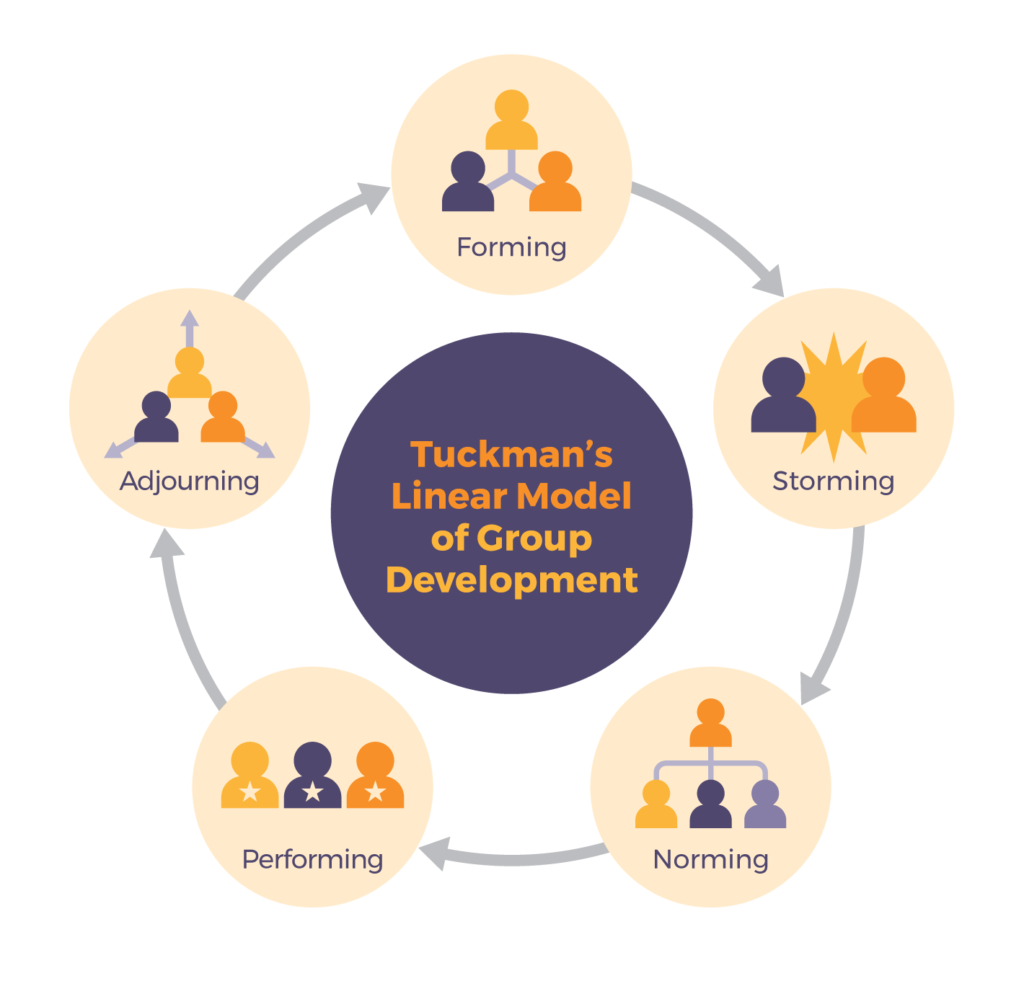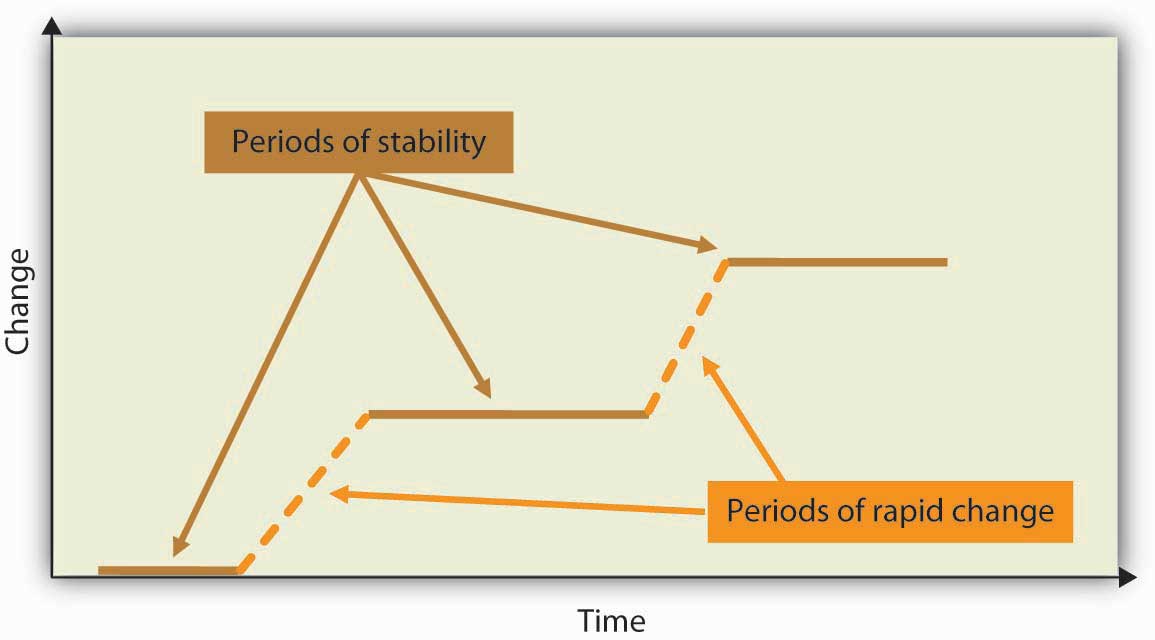4.3 – Group Development

From the time they are formed, groups evolve and can go through a variety of changes throughout their life cycles. Researchers have sought to identify common patterns in group development. These are referred to as descriptive models (Beebe & Masterson, 2016). Descriptive models can help us make sense of our group experiences by describing what might be ‘normal’ or ‘typical’ group processes. In the following sections, we will discuss two examples of descriptive models of group development — Tuckman’s model and punctuated equilibrium.
Tuckman Model of Group Development
American organizational psychologist Bruce Tuckman presented a robust model in 1965 that is still widely used today. Based on his observations of group behavior in a variety of settings, he proposed a four-stage map of group evolution, also known as Tuckman’s model of group development (Tuckman, 1965). Later he enhanced the model by adding a fifth and final stage, the adjourning phase. Interestingly enough, just as an individual moves through developmental stages such as childhood, adolescence, and adulthood, so does a group, although in a much shorter period. According to this theory, to successfully facilitate a group, the leader needs to move through various leadership styles over time. Generally, this is accomplished by first being more directive, eventually serving as a coach, and later, once the group can assume more power and responsibility for itself, shifting to a delegator. While research has not confirmed that this is descriptive of how groups progress, knowing and following these steps can help groups be more effective. For example, groups that do not go through the storming phase early on will often return to this stage toward the end of the group process to address unresolved issues. Another example of the validity of the group development model involves groups that take the time to get to know each other socially in the forming stage. When this occurs, groups tend to handle future challenges better because the individuals have an understanding of each other’s needs.

Forming
In the forming stage, the group comes together for the first time. The members may already know each other or they may be total strangers. In either case, there is a level of formality, some anxiety, and a degree of guardedness as group members are not sure what is going to happen next. “Will I be accepted? What will my role be? Who has the power here?” These are some of the questions participants think about during this stage of group formation. Because of the large amount of uncertainty, members tend to be polite, conflict-avoidant, and observant. They are trying to figure out the “rules of the game” without being too vulnerable. At this point, they may also be quite excited and optimistic about the task at hand, perhaps experiencing a level of pride at being chosen to join a particular group. Group members are trying to achieve several goals at this stage, although this may not necessarily be done consciously. First, they are trying to get to know each other. Often this can be accomplished by finding some common ground. Members also begin to explore group boundaries to determine what will be considered acceptable behavior. “Can I interrupt? Can I leave when I feel like it?” This trial phase may also involve testing the appointed leader or seeing if a leader emerges from the group. At this point, group members are also discovering how the group will work in terms of what needs to be done and who will be responsible for each task. This stage is often characterized by abstract discussions about issues to be addressed by the group; those who like to get moving can become impatient with this part of the process. This phase is usually short, perhaps a meeting or two.
Storming
Once group members feel sufficiently safe and included, they tend to enter the storming phase. Participants focus less on keeping their guard up as they shed social facades, becoming more authentic and more argumentative. Group members begin to explore their power and influence, and they often stake out their territory by differentiating themselves from the other group members rather than seeking common ground. Discussions can become heated as participants raise contending points of view and values, or argue over how tasks should be done and who is assigned to them. It is not unusual for group members to become defensive, competitive, or jealous. They may even take sides or begin to form cliques within the group. Questioning and resisting direction from the leader is also quite common. “Why should I have to do this? Who designed this project in the first place? Why do I have to listen to you?” Although little seems to get accomplished at this stage, group members are becoming more authentic as they express their deeper thoughts and feelings. What they are really exploring is “Can I truly be me, have power, and be accepted?” During this chaotic stage, a great deal of creative energy that was previously buried is released and available for use, but it takes skill to move the group from storming to norming. In many cases, the group gets stuck in the storming phase.
Avoid Getting Stuck in the Storming Phase
There are several steps you can take to avoid getting stuck in the storming phase of group development. Try the following if you feel the group process you are involved in is not progressing:
- Normalize conflict. Let members know this is a natural phase in the group formation process.
- Be inclusive. Continue to make all members feel included and invite all views into the room. Mention how diverse ideas and opinions help foster creativity and innovation.
- Make sure everyone is heard. Facilitate heated discussions and help participants understand each other.
- Support all group members. This is especially important for those who feel more insecure.
- Remain positive. This is a key point to remember about the group’s ability to accomplish its goal.
- Don’t rush the group’s development. Remember that working through the storming stage can take several meetings.
Once group members discover that they can be authentic and that the group is capable of handling differences without dissolving, they are ready to enter the next stage, morning.
Norming
“We survived!” is the common sentiment during the norming phase. Group members often feel elated at this point, and they are much more committed to each other and the group’s goal. Feeling energized by knowing they can handle the “tough stuff,” group members are now ready to get to work. Finding themselves more cohesive and cooperative, participants find it easy to establish their own ground rules (or norms) and define their operating procedures and goals. The group tends to make big decisions, while subgroups or individuals handle the smaller decisions. Hopefully, at this point, the group is more open and respectful toward each other, and members ask each other for both help and feedback. They may even begin to form friendships and share more personal information. At this point, the leader should become more of a facilitator by stepping back and letting the group assume more responsibility for its goal. Since the group’s energy is running high, this is an ideal time to host a social or team-building event.
Performing
Galvanized by a sense of shared vision and a feeling of unity, the group is ready to go into high gear. Members are more interdependent, individuality and differences are respected, and group members feel themselves to be part of a greater entity. At the performing stage, participants are not only getting the work done, but they also pay greater attention to how they are doing it. They ask questions like, “Do our operating procedures best support productivity and quality assurance? Do we have suitable means for addressing differences that arise so we can preempt destructive conflicts? Are we relating to and communicating with each other in ways that enhance group dynamics and help us achieve our goals? How can I further develop as a person to become more effective?” By now, the group has matured, becoming more competent, autonomous, and insightful. Group leaders can finally move into coaching roles and help members grow in skill and leadership.
Adjourning
Just as groups form, so do they end. For example, many groups or teams formed in a business context are project-oriented and therefore are temporary. Alternatively, a working group may dissolve due to organizational restructuring. Just as when we graduate from school or leave home for the first time, these endings can be bittersweet, with group members feeling a combination of victory, grief, and insecurity about what is coming next. For those who like routine and bond closely with fellow group members, this transition can be particularly challenging. Group leaders and members alike should be sensitive to handling these endings respectfully and compassionately. An ideal way to close a group is to set aside time to debrief (“How did it all go? What did we learn?”), acknowledge each other, and celebrate a job well done.
VIDEO – TUCKMAN’S TEAM BUILDING MODEL
The Punctuated-Equilibrium Model
As you may have noted, the five-stage model we have just reviewed is a linear process. According to the model, a group progresses to the performing stage, at which point it finds itself in an ongoing, smooth-sailing situation until the group dissolves. In reality, subsequent researchers, most notably Joy H. Karriker, have found that the life of a group is much more dynamic and cyclical (Karriker, 2005). For example, a group may operate in the performing stage for several months. Then, because of a disruption, such as a competing emerging technology that changes the rules of the game or the introduction of a new CEO, the group may move back into the storming phase before returning to performing. Ideally, any regression in the linear group progression will ultimately result in a higher level of functioning. Proponents of this cyclical model draw from behavioral scientist Connie Gersick’s study of punctuated equilibrium (Gersick, 1991).
The concept of punctuated equilibrium was first proposed in 1972 by paleontologists Niles Eldredge and Stephen Jay Gould, who both believed that evolution occurred in rapid, radical spurts rather than gradually over time. Identifying numerous examples of this pattern in social behavior, Gersick found that the concept applied to organizational change. She proposed that groups remain fairly static, maintaining a certain equilibrium for long periods. Change during these periods is incremental, largely due to the resistance to change that arises when systems take root and processes become institutionalized. In this model, revolutionary change occurs in brief, punctuated bursts, generally catalyzed by a crisis or problem that breaks through the systemic inertia and shakes up the deep organizational structures in place. At this point, the organization or group has the opportunity to learn and create new structures that are better aligned with current realities. Whether the group does this is not guaranteed. In sum, in Gersick’s model, groups can repeatedly cycle through the storming and performing stages, with revolutionary change taking place during short transitional windows. For organizations and groups who understand that disruption, conflict, and chaos are inevitable in the life of a social system, these disruptions represent opportunities for innovation and creativity.

EXERCISES – Group Development
- Why do people often join groups? What are some reasons you have joined groups in the past?
- Do people perform more effectively when alone or when part of a group? Under what conditions?
- If you were a college professor, what would you do to increase the success of in-class groups and teams?
- What do descriptive models do for us? How might they be useful to groups?
- Have you observed a group going through these phases in the past? What can you learn from those experiences?
KEY TAKEAWAYS
Tuckman (1965) describes the five stages as follows:
- Forming: Members come together, learn about each other, and determine the purpose of the group.
- Storming: Members engage in more direct communication and get to know each other. Conflicts between group members will often arise during this stage.
- Norming: Members establish spoken or unspoken rules about how they communicate and work. Status, rank, and roles in the group are established.
- Performing: Members fulfill their purpose and reach their goal.
- Adjourning: Members leave the group
(eCampusOntario, 2018)
a period of orientation and getting acquainted
a period marked by conflict and competition as individual personalities emerge
a phase of consensus around leaders and member roles
a phase of well-established consensus and cooperation where the team is mature, organized, and well-functioning
a phase where most of the team's goals have been accomplished

